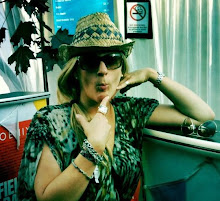There has always been this totally inexplicable and unwarranted part of me that likes to think I'm a bit of an amateur photographer. Quite frankly this is complete and utter lunacy. I think it might have first surfaced as a bit of an aspiration when I was in my early 20's and I had the most wonderful, traditional film, Pentax camera. I would take so many photos and I remember the delight I would feel finishing a roll of film, storing it away until I had a few stocked up and then taking them to be developed. There was always such an excitement when the photos were ready to be picked up. I would always go to the Boots in Eldon Square in Newcastle where the photo lab was on the ground floor. Once I'd picked up the fat, heavy envelopes containing my endless memories, in a mad dash, they'd be open and clumsily thumbed through before I'd even reached the top of the escalators.
And I did take good photos. I think I do have a good eye for a photograph but as cameras developed and went digital, I struggled massively to understand how they work. Cameras are not logical. They are completely illogical and my brain just doesn't compute. Its all to do with the numbers you have to deal with in setting the aperture, shutter speed and ISO to get a good photo. I know that with masses of practise it would probably become second nature but if you're not completely invested in something like this, you just get lazy, forgetful and if you're me, frustrated and so ultimately give up and do it half-heartedly.
I have done a photography course before, years ago but for some reason it made very little impression on me. Perhaps I was still too much of a beginner with DSLR cameras and so was just overwhelmed, I don't know. These days, I know the basics but I just have to take the time to get it completely clear in my mind and put it into practise.
So, I thought I'd try again with a nice, short, three-hour class in order to keep my brain from vomiting. Having seen some beautiful photos on her website, I was looking forward to meeting the teacher,
Matat Levin. We met in Camden and as luck would have it, there was only one other person in the class so I felt like we would get a lot of attention. We sat in a park for the first half of the morning to do the theory. We did get off to a bit of a rocky start because it was Matat's very first class as a teacher and also, myself and the other girl taking the class were at quite different stages. So there was a lot of toing and froing and perhaps not enough preparation and question-asking, but in the end we got there and I got a lot of useful information.
We talked about each of the three components that are all required to work together, when taking photos in manual mode. ISO is easy - I totally get that this is the sensitivity to light, or how the camera interprets light, and so when there is less light, you have to increase the ISO. I actually now feel a lot more confident with shutter speed and don't freak out at the numbers. Its simple - its how long you let the light in for so 1/500 is a lot quicker than 1/25. Duh. But also its good to have in my mind that to avoid blurriness, you should have a faster shutter speed. I've never quite made that connection.
Finally, the aperture. Oh the aperture, this is my achilles heel; really, the only one I struggle with oh so much. Why does it have to be so complicated and topsy-turvy for my childlike, simpleton brain. Ok so quickly (more for me than you!), the aperture is the size of the lens opening. It controls the amount of light let in: a larger aperture lets in more light, while a smaller aperture lets in less light. But, here's the thing, the smaller the f-number (what aperture is measured in) the larger the opening. That just doesn't make logical sense to me. Also, the aperture has a second function - to increase or decrease the depth of field. The larger the aperture, the depth of field will be shallower and almost nothing will be in focus. The smaller the aperture, the sharper the image. My mind just boggles at this. Am I just a bit thick?
Lastly, we talked about composition and actually how to compose a good photo. Surprisingly, I didn't really know about the rule of thirds. This is where you divide the plain into thirds both horizontally and vertically, and place your subject on any of the line-crossings. Below is a really good example of two photos that I took; one without having thought about the rule of thirds and the other where I had.
Then we went into the markets and put our theory into practise. I didn't do too badly and actually took quite a few photos of things where the light was very difficult to capture and I know full well on any normal occasion, I would have just given up. This time, I sort of knew what I was doing. Sort of. It made me happy. Matat did well. I think with some fine-tuning and mega practise I might start taking some decent photos.














0 Comments:
Post a Comment